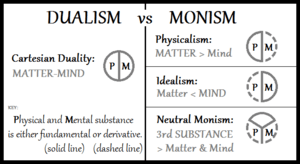Monism facts for kids
Monism is a big idea in philosophy that says everything in the universe is made of just one basic kind of stuff. It means that all things, even if they seem separate, are actually connected and part of a single, unified whole. Think of it like a giant puzzle where all the pieces, no matter how different they look, fit together to form one complete picture.
This idea is different from thinking that there are two main kinds of things (like mind and body being totally separate), which is called Dualism. Monism suggests that everything we see, feel, and think comes from one single source or substance.
Contents
What is Monism?
Monism comes from the Greek word "monos," meaning "alone" or "single." It's a way of looking at the world that tries to find a single explanation for everything. Instead of seeing many different things, monists believe there's an underlying unity to all existence.
One Kind of Reality
Imagine you have a toy car. You can see its wheels, its body, and its windows. They all look different, but they are all part of the same car. Monism suggests that the entire universe is like that car – all its parts are just different forms of one fundamental thing.
This "one thing" could be:
- Matter: Everything is physical stuff.
- Mind: Everything is mental or spiritual.
- Something Else: A neutral substance that isn't quite mind or matter.
Types of Monism
There are different ways philosophers have thought about what this "one thing" might be.
Material Monism
This idea says that the only thing that truly exists is physical matter and energy. Everything, including our thoughts and feelings, is just a result of physical processes in the brain.
- Example: A scientist who believes that the brain creates the mind, and there's no separate "soul" or "spirit," is thinking in a material monist way. This view is also called physicalism.
Idealistic Monism
In contrast, idealistic monism says that the only thing that truly exists is mind or consciousness. Physical objects are not real on their own but are just ideas or perceptions within a mind.
- Example: Some ancient Indian philosophies, like Advaita Vedanta, suggest that the ultimate reality is a single, universal consciousness, and the world we see is an illusion or a dream within that consciousness.
Neutral Monism
This view suggests that reality is made of a single, neutral substance that is neither mental nor physical. Both mind and matter are just different ways of looking at or experiencing this neutral substance.
- Example: The philosopher Baruch Spinoza believed in a single substance he called "God or Nature," which had both thought (mental) and extension (physical) as its attributes.
Why is Monism Important?
Monism has been a very important idea throughout the history of philosophy and religion. It helps people think about big questions like:
- What is the universe made of?
- What is the connection between our minds and our bodies?
- Is there a single, unifying force behind everything?
Understanding monism helps us see how different thinkers have tried to make sense of the world around us. It encourages us to look for connections and unity, even when things seem very different.
Related pages
Images for kids
-
Adi Shankara with Disciples, by Raja Ravi Varma (1904)
See also
 In Spanish: Monismo para niños
In Spanish: Monismo para niños



